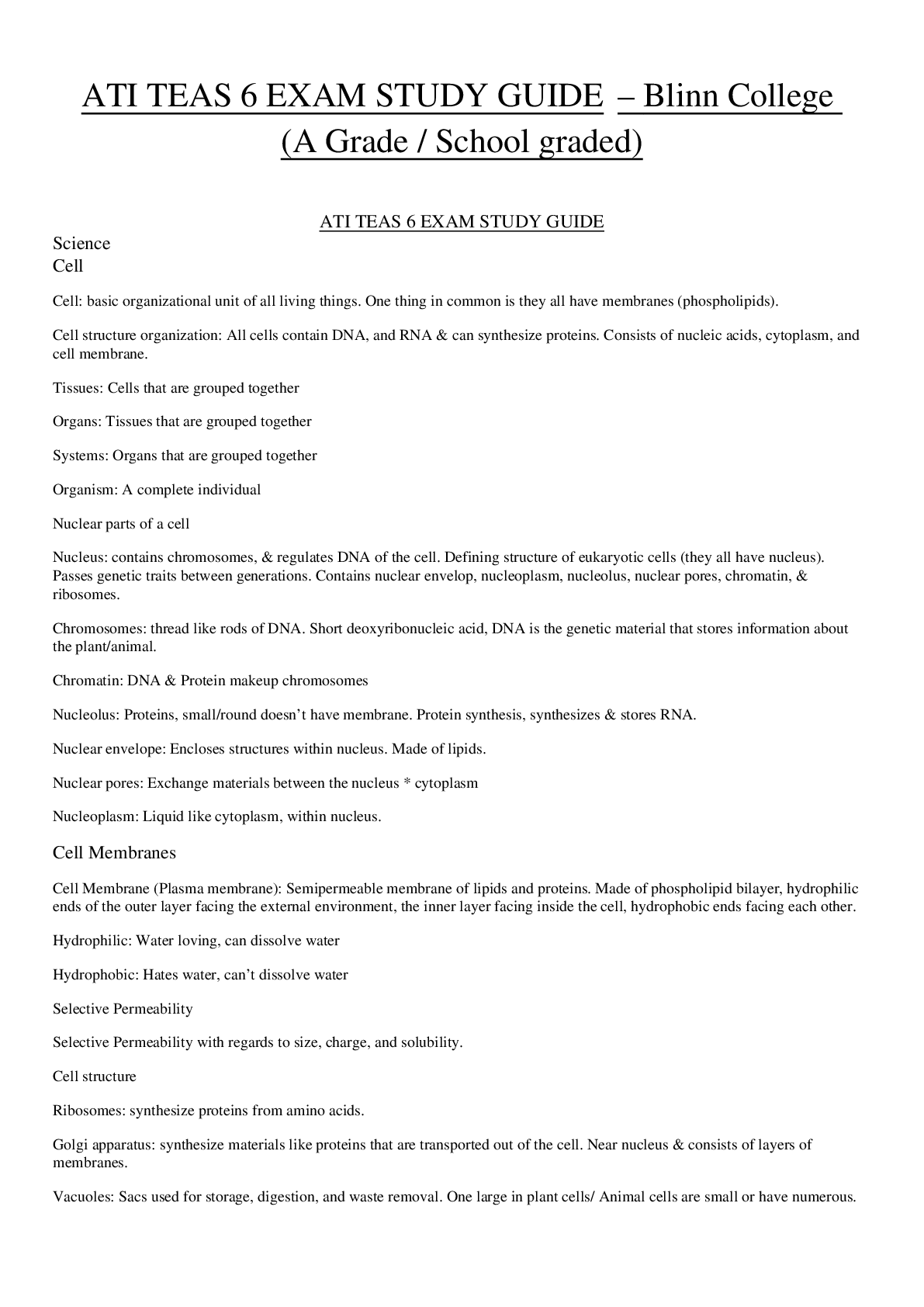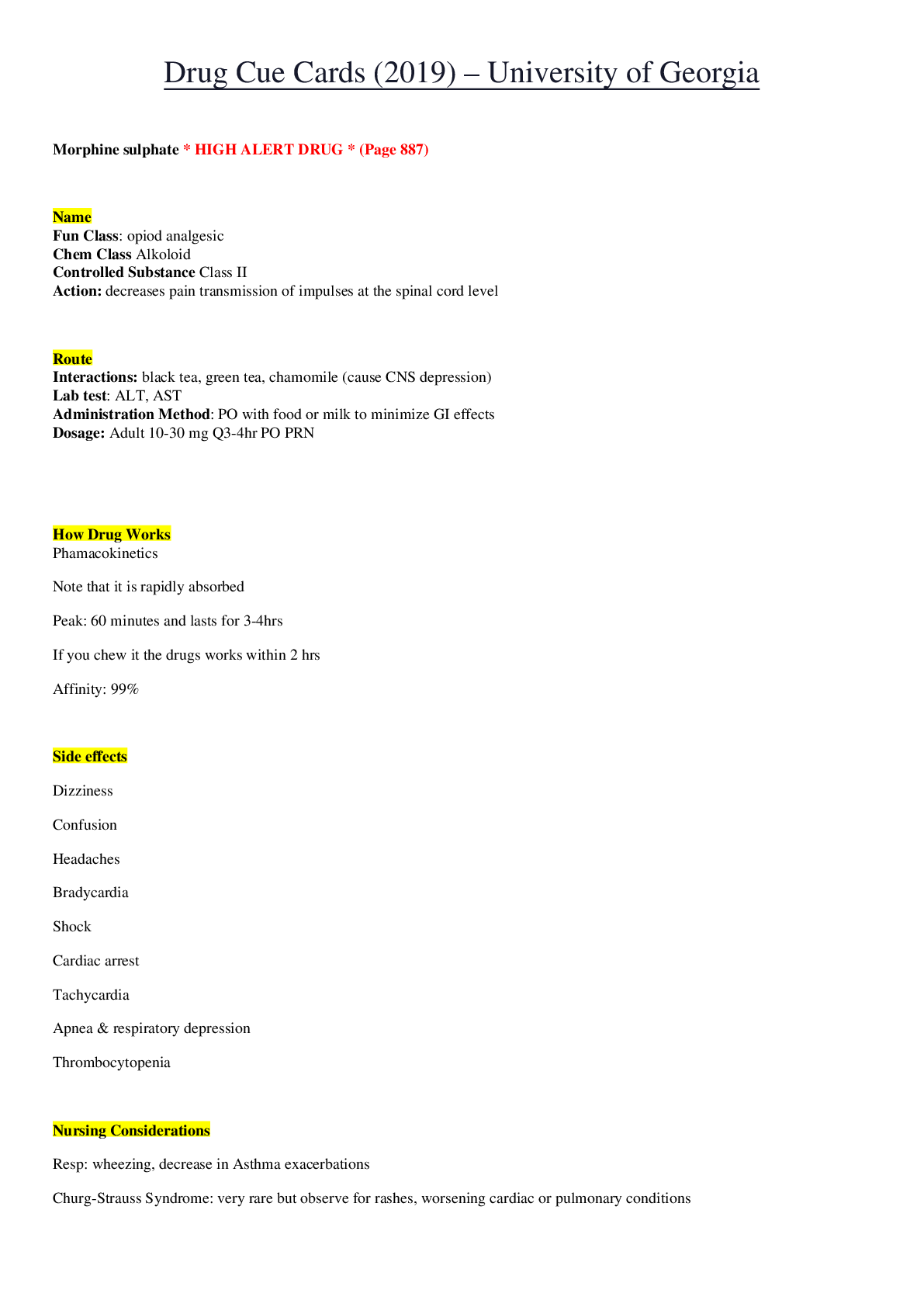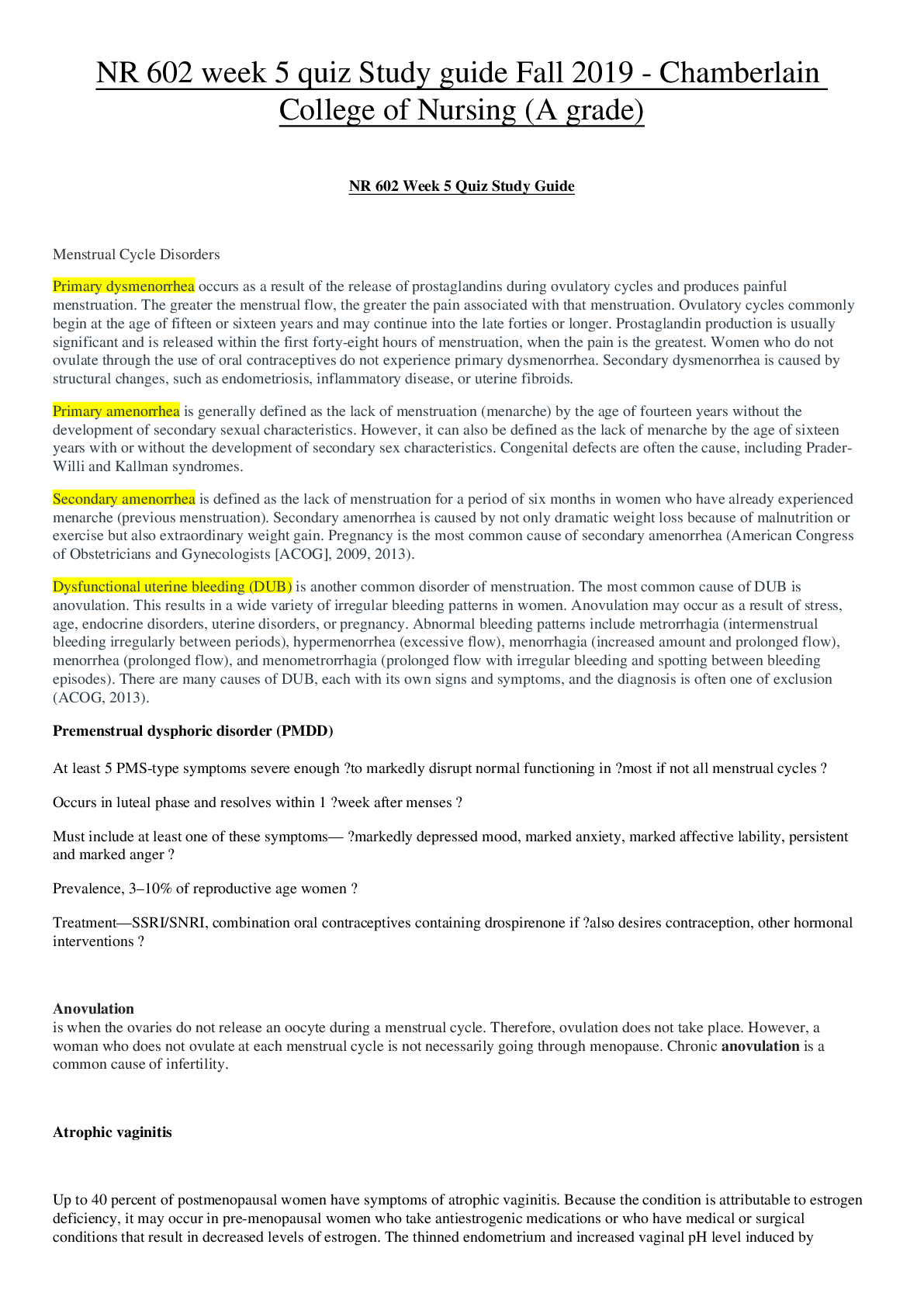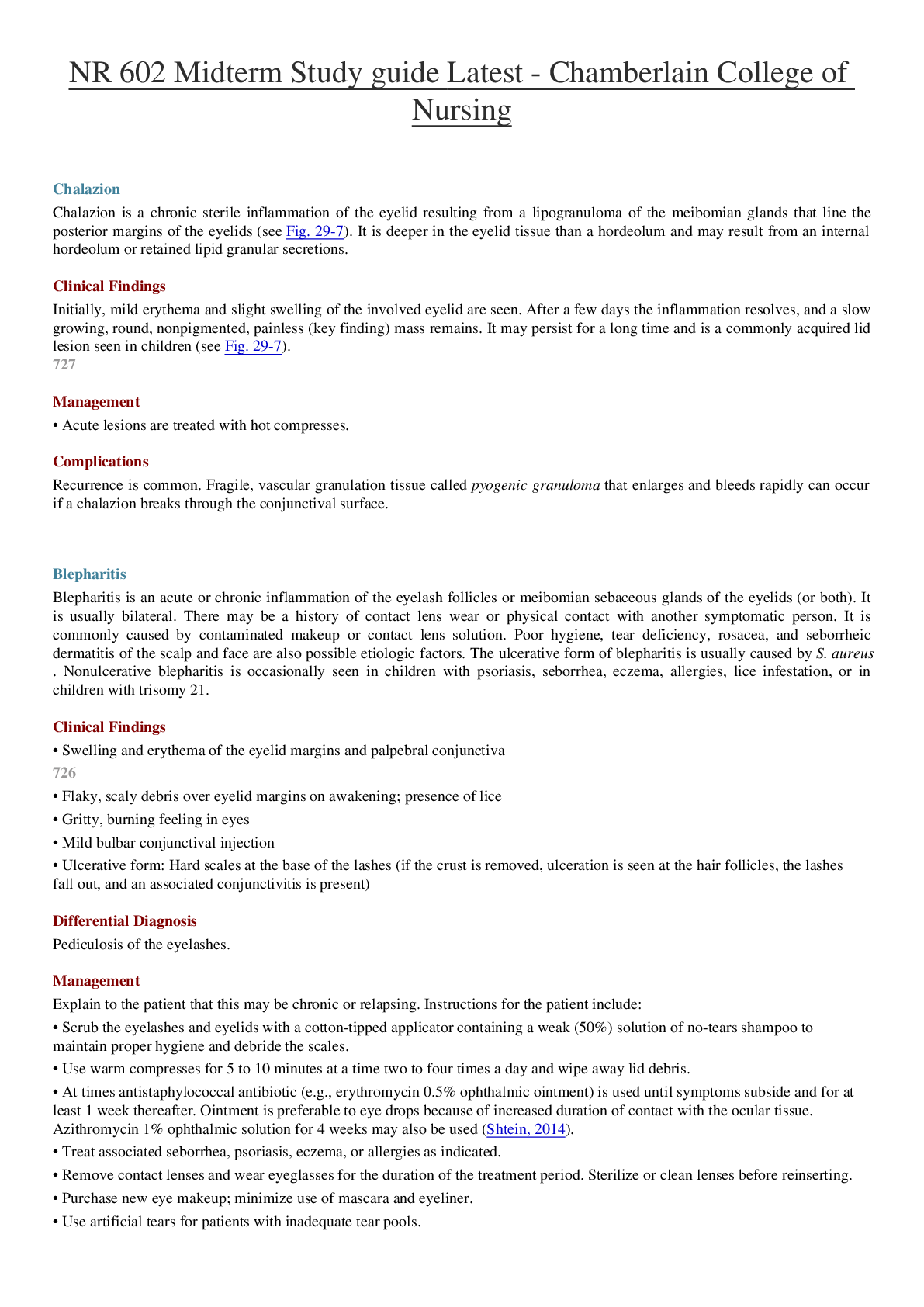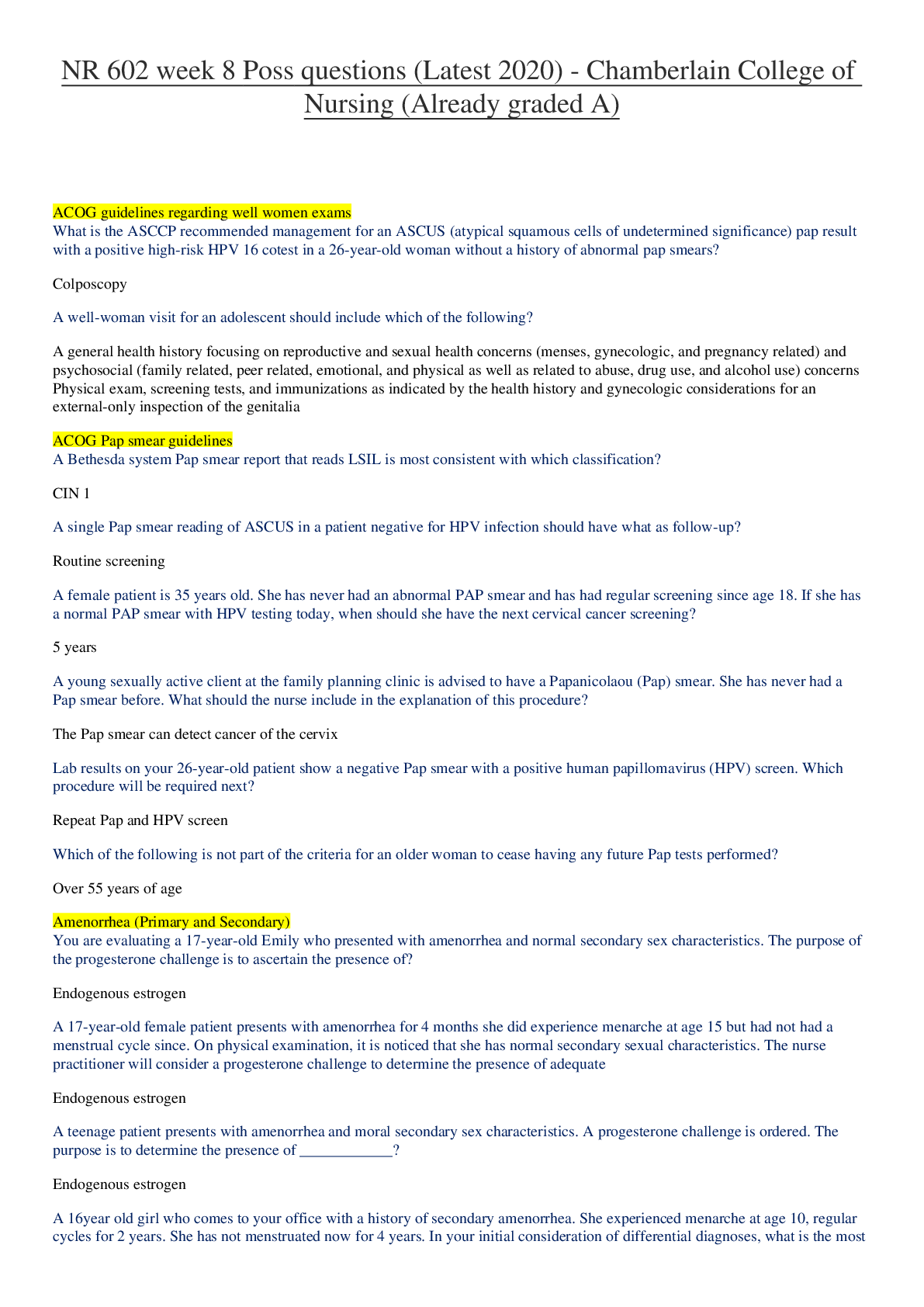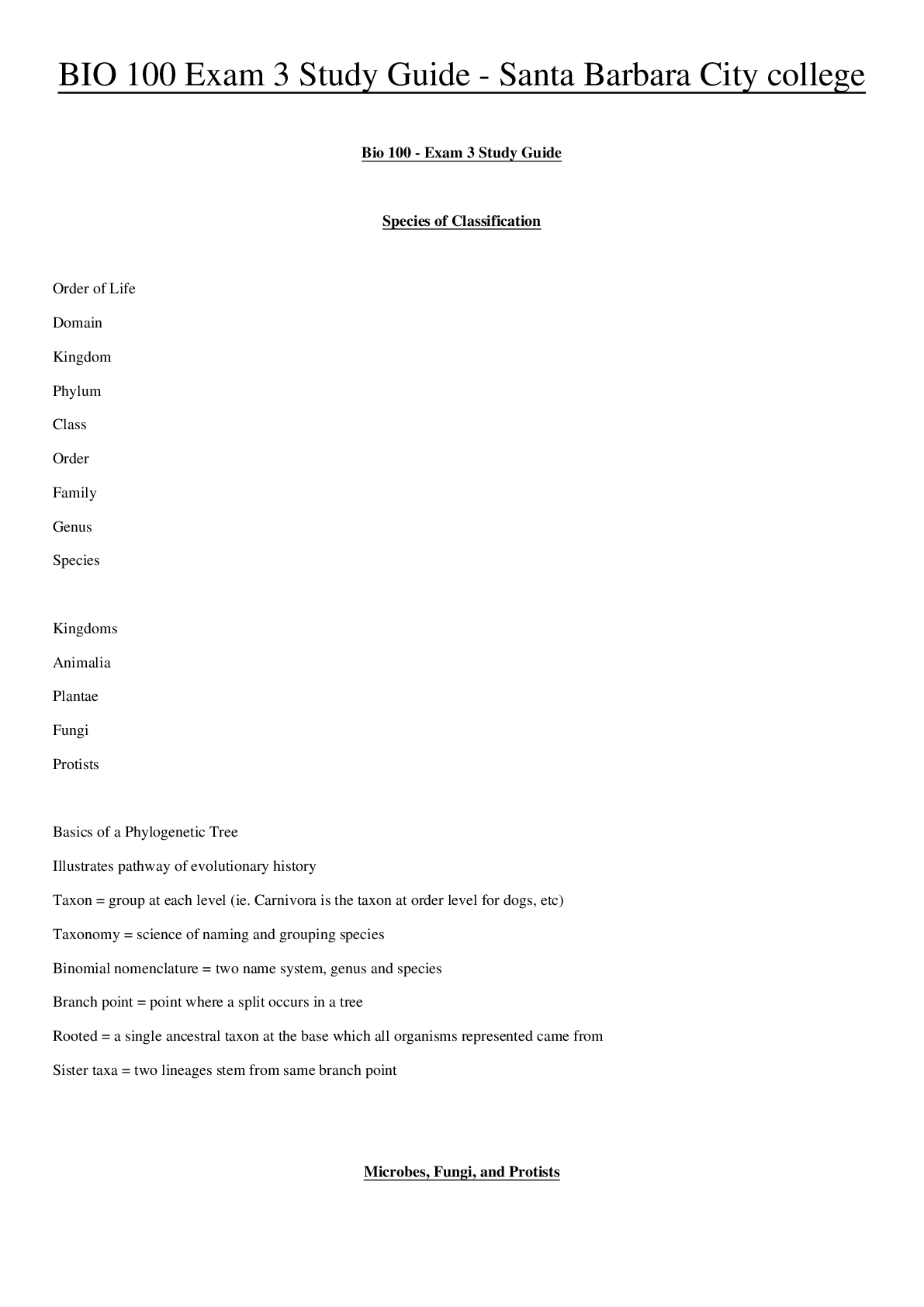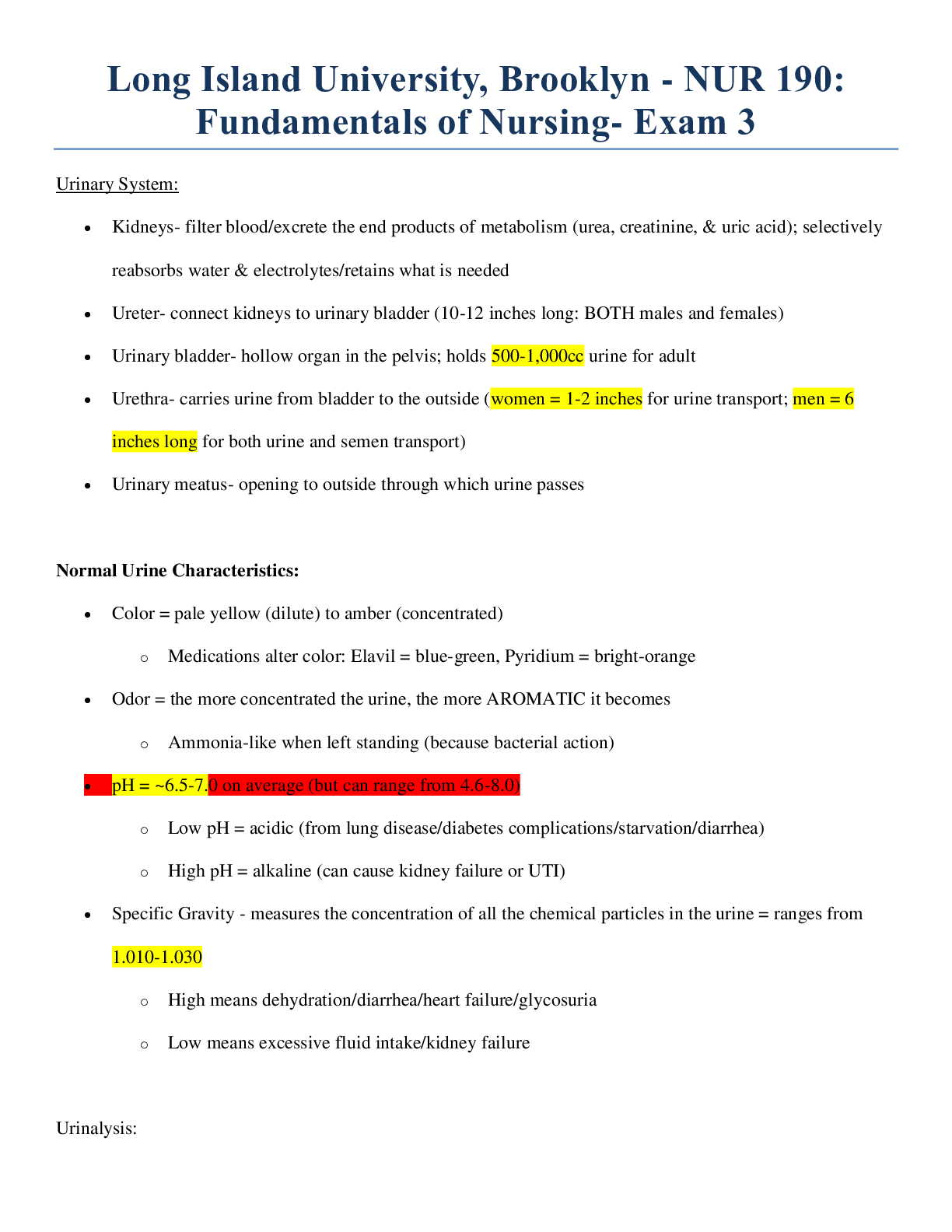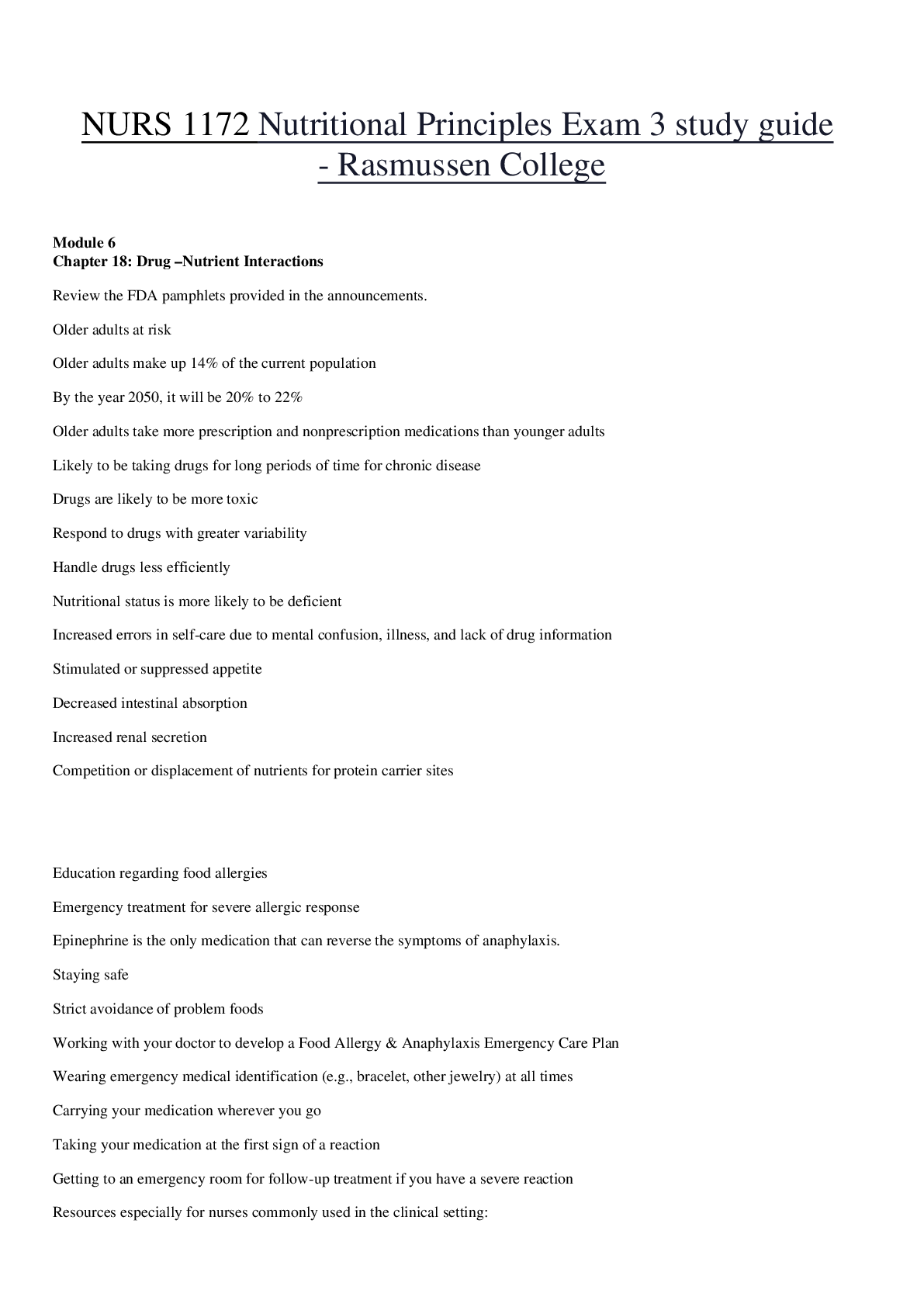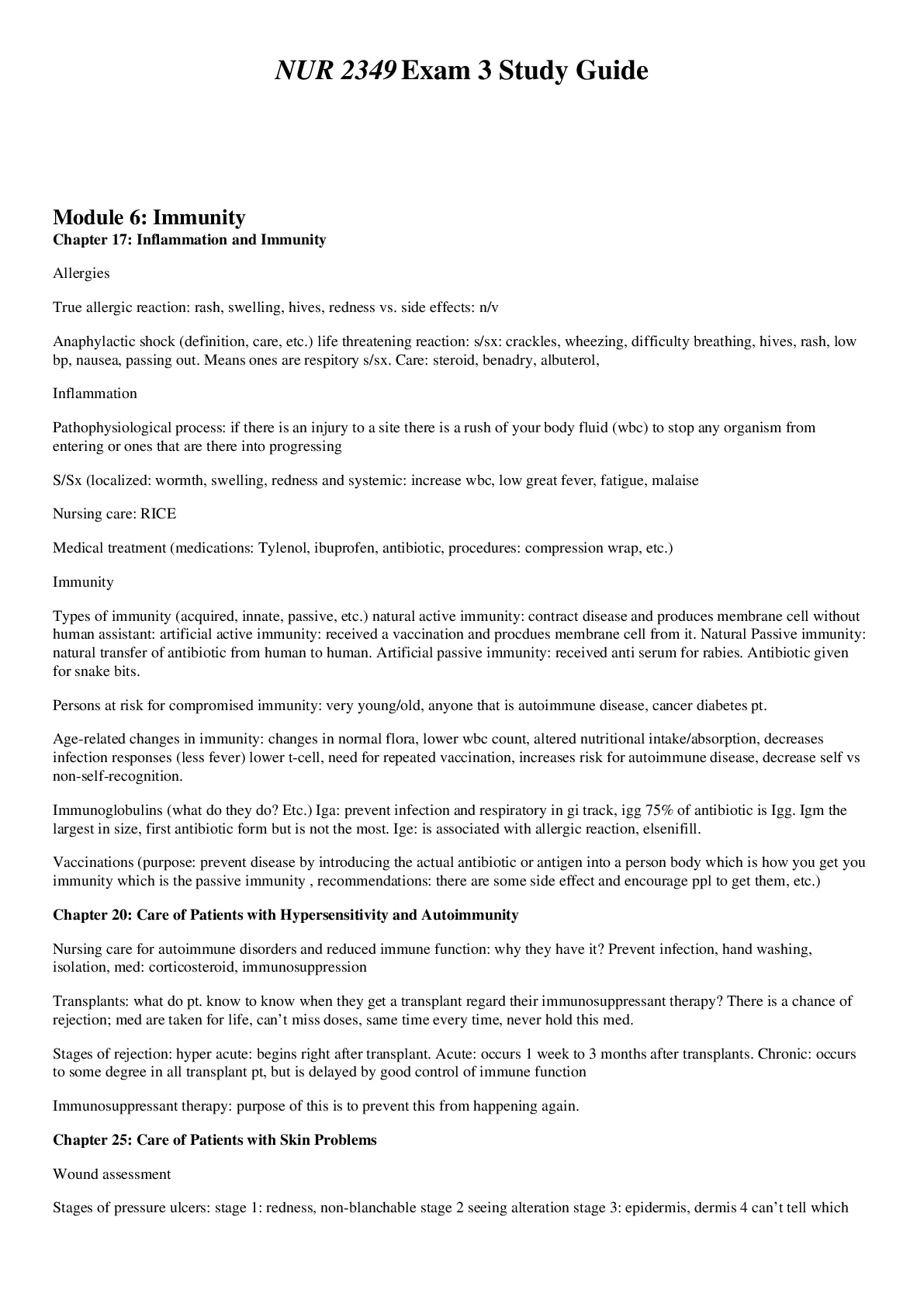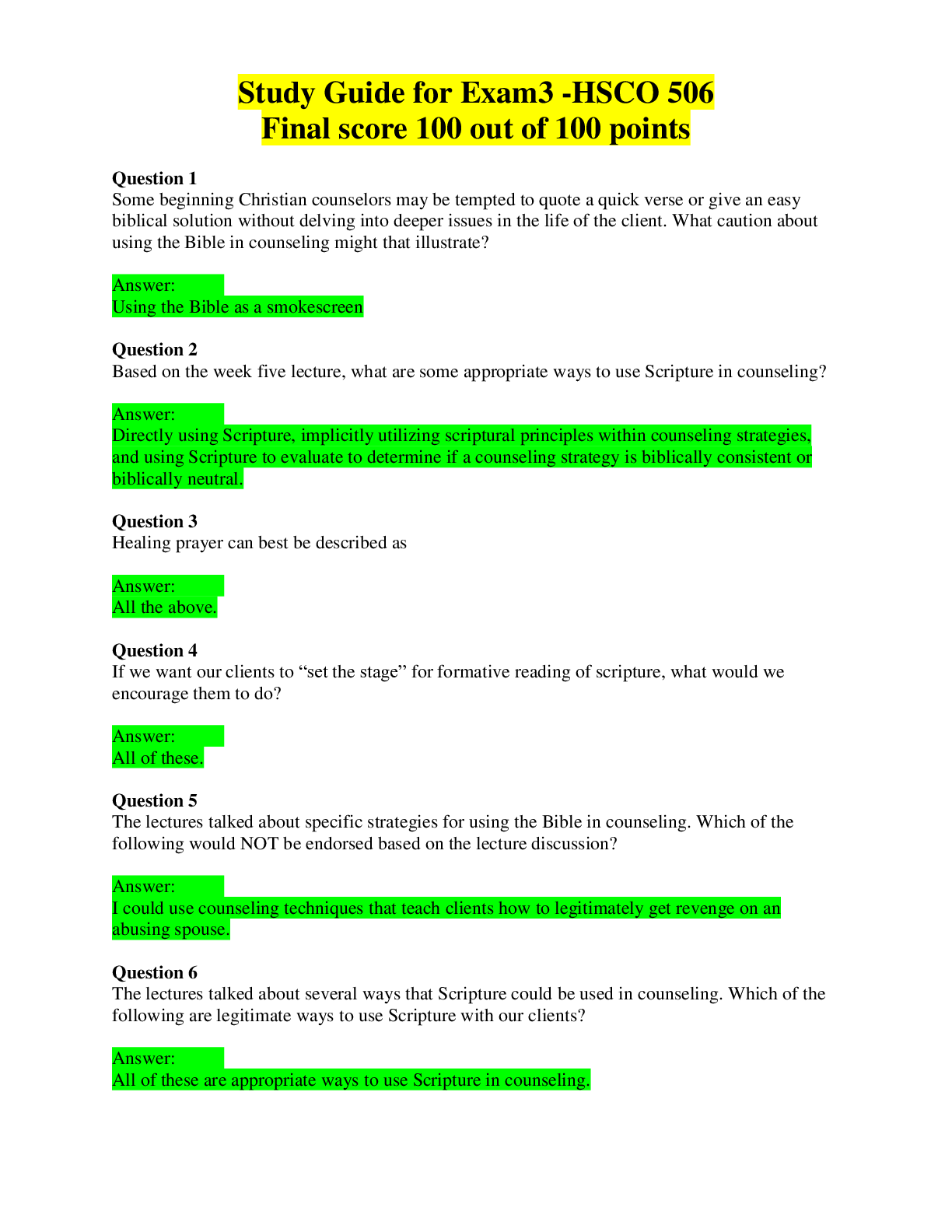Biology > STUDY GUIDE > NSG 331 Exam 3 study guide 2019/2020 – Marian University | NSG331 Exam 3 study guide 2019/2020 (All)
NSG 331 Exam 3 study guide 2019/2020 – Marian University | NSG331 Exam 3 study guide 2019/2020
Document Content and Description Below
NSG 331 Exam 3 study guide 2019/2020 – Marian University Integumentary Disorders Assessment of Integumentary System • Health History o Previous trauma, surgery, diseases/manifestations, jaun... dice, cyanosis, delayed wound healing, pallor o Food sensitivities, pet or drug allergies o Reactions to insect bites / bee stings o Chronic exposure to UV light – tanning bed/radiation o Medication Hx: reactions to prescribed, OTC, herbal, or vitamins ♣ Any medications prescribed for dermatologic problems o Self-care / hygiene, use of SPF o Ask about intertriginous areas – skin surfaces overlap and rub on each other (obese patients) o Elimination pattern – fluid balance issue manifestations – dehydration, edema, pruritis o Sensation issues – response to stimuli, reduced response, or painful response • Focused Assessment o Subjective o Objective: Diagnostic o Objective: Physical Examination ♣ Private exam room, moderate temp, good lighting (daylight preferred) ♣ Ensure comfort of patient in gown and can access all skin areas ♣ Systematic – head to toe ♣ Compare symmetric parts ♣ General inspection, then lesion-specific exam ♣ Metric system for all measurements ♣ Inspection • Most important aspect is change – any variations from what is normal for that patient • Most reliable areas to assess erythema, cyanosis, pallor, and jaundice: • Conjunctiva, sclera, nail beds, lips, buccal mucosa • True skin color = photo-protected areas = buttocks • Angioma – benign tumor of blood/lymph vessels • Petechiae – tiny, flat, purplish red pinpoint lesions on skin • Purpura – purple colored spots – ecchymosis and/or hemorrhage • Ecchymosis – bruising • Blanching – changes color with pressure and color returns when pressure is removed • Redness is due to dilated blood vessels • Non-blanching – color doesn’t return after pressure is removed • Subcutaneous or intradermal bleeding or non-vascular lesion • Primary skin lesion – lesion on previously unaltered skin – table 22-5 • Secondary skin lesion – lesions that change with time or occur b/c of factors such as: • Scratching, infection ♣ Palpate – temperature, turgor, moisture, and texture • Use the back of your hand for temperature ♣ Dark skin assessment – color easiest to assess in areas where epidermis is thin, and pigment not influenced or affected by sun exposure – lips, mucous membranes, buccal mucosa, nail beds, and photo-protected areas (buttocks) • Rashes difficult to observe and must sometimes be palpated Skin Disorders Secondary Skin Disorders Assessment Variations • Cyanosis • Ecchymosis • Erythema • Jaundice • Pallor • Petechiae • Rash • Scar • Dark-skinned specific assessment variations • Keloid – overgrowth of collagenous tissue at the site of skin injury (ear-piercing) • Vitiligo – total loss of pigmentation in affected area • Dermatosis papulose nigra – small, pigmented wart-like papules, commonly on the face • Nevus of Ota – slate-gray/blue-gray birthmark located at the forehead and face around the eye area • Traction alopecia – result of trauma from hair rollers or tight braiding of hair (temporary or permanent) • Pseudofolliculitis – inflamm. response to ingrown hairs: occurs after shaving too closely in beard area Diagnostic Testing • Biopsies o Punch o Excisional o Incisional o Shave • Microscopic Tests o KOH, Tzanck test, cultures, slides, immunofluorescent • Miscellaneous o Wood’s lamp – use of UV light to assess substances that are fluorescent (bacteria, yeast, fluids) o Patch Test – used to assess allergic reactions to a variety of allergens Psoriasis Vulgaris • Chronic noninfectious inflammatory disease • Occurs worldwide • Equal in both genders • 15-50 years (big range) – usually develops before age 40 • Vulgaris is Latin for “common” • Genetic system disease with immunologic basis • Frequently manifests in the skin and joints • Clinical Manifestations • Red raised patches/white layer • May or may not itch • Symmetrical • Distribution: scalp, elbows, knees, genital and sacral regions • May become systemic • Course unpredictable • Treatment • Suppress T-Cell Activation (topical steroids,intralesion injections,retinoids,keratolytic agents) • Promote Desquamation (UVL with topicals) • Systemic Treatments (Methotrexate and Cyclosporine) • Nursing Measures • Self-concept issues • Teaching about medications • Risk for infections • Control causative factors Eczema / Dermatitis • Allergic contact dermatitis • Irritant dermatitis • Nummular eczema • Seborrheic dermatitis • Stasis dermatitis • Atopic dermatitis o Usually called eczema o Common, chronic, relapsing o Often begins in childhood o Familial hay fever, asthma, etc. o Increased prevalence o Worldwide o Manifestations ♣ Pruritus –major manifestation ♣ Dry skin ♣ Acute onset with red, oozing, crusting rash ♣ Intense scratching leads to lesions, infection and scarring o Treatment ♣ Hydrate the skin (soaks with colloidal oatmeal) ♣ Moisturize the skin ♣ Remove allergens ♣ Reduce inflammation ♣ Treat infection Nursing Management of Dermatologic Problems • Wet Dressings – damaged, oozing skin – remove crust and scabs – tap water at room temp/vinegar o Relieve itching o Suppress inflammation o Debride the wound • Baths – large areas of the body – colloidal oatmeal (Aveeno) • Topical Medications – Table 23-12 – occlude with plastic wrap to increase absorption • Control Pruritus – break the itch-scratch cycle to prevent excoriation and lichenification o Lichenification – thickening of the epidermis with exaggerated markings resembling a washboard ♣ Caused by chronic itching / rubbing of the skin • Prevention of Spread – gloves and adamant hand washing • Prevention of Secondary Infections – particularly to existing skin lesions • Specific skin care – educate patient on skin care after dermatologic procedures and hygiene o Wounds kept moist and covered heal more rapidly, leave scab/crust undisturbed • Physiologic effects of chronic dermatologic problems Acne Vulgaris • Comedomes (white heads (closed) and black heads (open)), papules, pustules, nodules, cysts • 12-35, puberty, family history, androgens stimulate the sebaceous glands, accumulated sebum plugs the pilosebaceous ducts, flare up with use of corticosteroids and androgen-dominant birth control pills/pre-menses • Dx- history, exam • Management • Reduce bacterial colonies • Topical-salicylic acid benzyl peroxide, Vit. A acid, tetracycline, clindamycin, erythromycin • Systemic- tetracycline PO, oral retinoids (vit A), Accutane • Surgical- cryosurgery, dermabrasion scarring • Nursing Management • Diet restrictions are not recommended • Wash twice a day avoid over scrubbing, oil free cosmetics, no popping, no squeezing Benign Conditions of the Skin • Seborrheic Keratosis o Benign, familial, incr. with age o Irregularly round or oval, papules or plaques, well-defined shape, appearance of being stuck on o Increase in pigmentation with time o Usually many and itchy o Well-defined shape, appearance of being stuck on o Treatment: remove for cosmetic or irritating reasons, biopsy if unable to distinguish from melanoma • Lipoma: Benign tumor of adipose tissue o Characteristics: ♣ Single or multiple ♣ Benign subcutaneous tumors ♣ Soft, rounded or lobulated ♣ Movable against overlying skin ♣ Small but may enlarge to >6 cm ♣ Occur on neck, trunk and extremities o Treatment: ♣ Biopsy ♣ Excision if indicated • Lentigo: increased number of normal melanocytes in basal layer of epidermis o “age spots”, “liver spots” o Characteristics: ♣ Hyperpigmented ♣ Brown to black macules ♣ “age spots” o Treatment: ♣ Evaluate carefully for progression ♣ Can evolve to lentigo maligna melanoma ♣ Liquid nitrogen Malignant Skin Neoplasms – Table 23-4 • Nonmelanoma Skin Cancers o Actinic Keratosis – AKA solar keratosis • Premalignant skin lesions – most common of all pre-cancerous skin lesions • Hyperkeratotic papules and plaques on sun exposed areas • Incidence: nearly all older white population • Lesion: irregularly shaped, flat, slightly erythematous papule with indistinct borders and overlying hard keratotic scale or horn • Treatment: cryosurgery, surgical removal, topicals, dermabrasion, etc. • Aggressive d/t to inability to distinguish from squamous cell carcinoma o Basal Cell Carcinoma • Locally invasive malignancy arising from epidermal basal cells • Most common, least deadly – middle aged to older adults • Occurs most likely at the site of a previous trauma – scar, thermal burns, injuries • Erythematous, pearly, sharply defined, may become nodular and ulcerative • Treatment, surgical excision, chemosurgery, electrosurgery, cryosurgery • Hard to distinguish from Melanoma – tissue biopsy needed to confirm Dx • Rarely metastasize – if left untreated can lead to massive tissue destruction o Squamous Cell Carcinoma • Malignant tumor of squamous cells of epidermis = keratinizing epidermal cells: sun exposed skin • At the base of an actinic keratosis or another lesion • Invasive, can be highly aggressive and metastasize - Less common than Basal Cell Carcinoma • Can lead to death if not treated early and/or correctly • Pipe, cigar, cigarettes – contribute to formation of SCC on mouth and lips • Immunosuppression leads to a dramatic increase in the incidence of SCC • Renal transplant Pts – 253-fold increase in the risk for SCC • Treatment: surgical excision, radiation, chemotherapy • Malignant Melanoma o Tumor arising in melanocytes o Cutaneous melanoma: MM that arises from the skin o Most deadly skin cancer o Ability to metastasize to any organ including brain and heart o Risk factors: • Chronic UV exposure – damages the DNA and causes mutations in genetic code • Fair skin and eyes • Genetic factors – 5-10% incidence if family member has it • Immunosuppression and dysplastic nevi (moles) – 25% of cases – continue to produce melanin o Prognosis determinants – tumor thickness at time of diagnosis • Breslow measurement – depth of tumor in mm • Clark level – depth of invasion of tumor o Nearly 100% curable if excised at stage 0 (in situ) • ABCDE’s of Melanoma o A. Asymmetry o B. Border irregularity o C. Color o D. Diameter o E. Evolving Atypical / Dysplastic Nevus • Appearance between common nevi(mole) and melanoma • Increased risk for melanoma • Often > 5mm across, irreg. border, variegated color, freq. multiple, after puberty, on back but may be on scalp or buttocks • Excisional biopsy for suspicious lesions Vascular Disorders Circulation through the heart Terms and Definitions • Systole: Contraction of heart muscle • Diastole: Relaxation of heart muscle – filling of ventricles • Stroke volume: Amount of blood ejected with each heart beat • Cardiac output: Amount of blood pumped by each ventricle in 1 minute o Normal 4-8 L/min • Cardiac index: CO divided by body surface area o Normal 2.8-4.2 L/min/m2 • Preload - Volume of blood in ventricles at end of diastole • Afterload - Peripheral resistance against which the left ventricle must pump Review Question A patient is receiving a drug that decreases afterload. To evaluate the patient’s response to this drug, what is most important for the nurse to assess? a. Heart rate b. Lung sounds c. Blood pressure d. Jugular venous distention Answer: C Rationale: Afterload is affected by size of the ventricle, wall tension, and arterial blood pressure. Comparison of Artery, Vein, and Capillary Structures and Functions of the Cardiovascular System • Regulation of CV system o Autonomic nervous system – sympathetic and parasympathetic nervous system ♣ Sympathetic speeds up heart/vasoconstriction, parasympathetic slows down/vasodilation o Baroreceptors – sensitive to stretch pressure – stimulation results in inhibition of sympathetic system o Chemoreceptors – sensitive to CO2 and pH – results in changes in RR and BP • Functions o Blood Pressure ♣ Systolic Blood Pressure (SBP) ♣ Diastolic Blood Pressure (DBP) ♣ BP= CO x SVR o Pulse Pressure – Difference b/n SBP and DBP o Mean Arterial Pressure ♣ MAP=(SBP+2DBP)/3 Age-Related Changes • Risk for CVD increases • Leading cause of death in adults>65 • Increased collagen, decreased elastin • Decreased response to stress • Heart valves become stiff and thick • Number of pacemaker cells decrease • Decreased number and function of β-adrenergic receptors • Blood vessels thicken and less elastic • Increase in SBP and decrease or no change in DBP • Incompetent venous valves • Orthostatic hypotension • Postprandial hypotension Assessment of the Cardiovascular System: Subjective Data • Health Information o History of present illness o Past health history – illnesses and manifestations (SOB, chest pain, etc.) o Past and current medications o Surgery or other treatments • Functional Health patterns o Health-perception-health mgmt – risk factors such as incr. lipds, HTN, lifestyle, DM, tobacco use o Nutrition-metabolic pattern – weight and diet history o Elimination pattern – fluid balance issues o Activity-rest pattern o Sleep-rest patterns - paroxysmal nocturnal dyspnea (SOB at night), othopnea, Cheyne-stroke resp. o Cognitive-perceptual pattern – syncope, language, and memory issues o Self-perception/self-concept pattern – body image, effects on ability to “keep up” with lifestyle o Role-relationship pattern o Sexuality-reproductive pattern o Coping-stress pattern o Values-belief pattern Physical Assessment of CV System • Vital Signs • Peripheral Vascular System o Inspection – skin (color, venous pattern, hair distr), edema, nail clubbing, stasis ulcers, lesions, JVD o Palpation – temperature, moisture, peripheral pulses, edema bilaterally, pitting edema, cap refill o Auscultation – bruit in narrowed or bulging artery • Thoracic Inspection and Palpation o Pulsations o Thrills o Heaves – sustained lifts in the chest wall in the pre-cordial area that can be seen or palpated • Can be caused by left ventricular hypertrophy o Point of maximal impulse (apical pulse) • Thoracic Auscultation o S1, S2 o S3 (ventricular gallop), murmurs, S4, pericardial friction rubs o Pulse deficit – diff b/n apical and radial pulse • Diagnostic Studies – Table 31-6, pg 673 • Blood Studies o CBC, CMP – O2 carrying capacity, cardiac enzymes – troponin, CK-MM, MB, BB o C-reactive protein (CRP) (liver) - acute inflammation – incr = artherosclerosis/initial heart event o Homocysteine – amino acid – protein catabolism – CVD, peripheral vasc. Disease, stroke o Cardiac natriuretic peptide – ANP and BNP – heart failure or respiratory issues (dyspnea) o Lipid Profiles – chylomicrons – exogenous triglycerides from dietary fat; LDL, HDL, triglycerides o Lipoprotein-associated phospholipase A2 • Chest X-ray – heart shape, size, anatomic changes in individual chambers – displacement / enlargement of heart • Electrocardiogram (ECG) – P, QRS, T waveforms – heart rate/function • Exercise / Stress Test – hearts response to physical stress • Cardiovascular magnetic resonance imaging (CMRI) – can find areas of an MI • Cardiac computed tomography – with or w/o contrast – images of heart, valves, great vessels, coronary circulat. • • Echocardiogram o Ultrasound of heart o With or without contrast – assists in defining images o Provides information regarding structures and motion of heart; abnormalities o Measures ejection fraction (EF) – percent of end-diastolic blood volume ejected during systole (LV fxn) o Stress echocardiography – combo of treadmill test and US images – wall motion abnormalities o Transesophageal echo (TEE) – more precise echo of heart surface than 2D – removes interference from chest wall and lungs - flexible endoscope with US transducer in tip for heart and great vessel images Hypertension • Incidence o Affects 1 in 3 adults in USA o One of most modifiable risk factor o High priority health concerns identified in Healthy People 2020 o 83% of people>20 were aware they had hypertension • Risk Factors o Nonmodifiable ♣ Family history ♣ Age ♣ Gender ♣ ethnicity o Modifiable ♣ Tobacco/alcohol use ♣ Diabetes ♣ Elevated serum lipids ♣ Excess dietary sodium ♣ Obesity ♣ Sedentary lifestyle ♣ Stress Review Question While performing blood pressure screening at a health fair, the nurse counsels which person as having the greatest risk for developing hypertension? a. A 56-year-old man whose father died at age 62 from a stroke b. A 30-year-old female advertising agent who is unmarried and lives alone c. A 68-year-old man who uses herbal remedies to treat his enlarged prostate gland d. A 43-year-old man who travels extensively with his job and exercises only on weekends Answer: a Rationale: History of a close blood relative (e.g., father to son) with hypertension is associated with an increased risk for developing hypertension; atherosclerosis is the most common cause of cerebrovascular disease. Hypertension is the major risk factor for cerebral atherosclerosis and stroke. Regulation of Blood Pressure • • Sympathetic Nervous System (SNS) • Baroreceptors • Vascular Endothelium – regulates vaso-dilating/constricting substances – nitric oxide (NO), prostacyclin (vasodilators) and endothelin (ET) (vasoconstrictor) • Renal System – RAAS, prostaglandins, natriuretic peptides • Endocrine System – epinephrine – incr HR and contractility Hypertension • Pathophysiology of PRIMARY • Persistently elevated systemic vascular resistance (SVR) • Abnormalities in any mechanism involved in maintenance of normal BP • Genetic links • Water and sodium retention • Stress and increased SNS activity – anger, fear, and pain – physiologic responses to stress • Altered renin-angiotensin-aldosterone system (RAAS) • Insulin resistance and hyperinsulinemia – incr. insulin levels stimulate SNS activity – impair NO mediated vasodilation; vascular hypertrophy; increased renal sodium reabsorption • Endothelial dysfunction – prolonged vasoconstriction response – high levels of endothelin • Eighth report of the Joint National Committee on Prevention, Detection, and Treatment of High BP • Goal: Reduce blood pressure • Either you have HTN or you don’t • If you are over 60 and do not have chronic kidney disease or diabetes, your goal is <150/90 mmHg • For everyone else, goal is 140/90 mm Hg • Three first line choices o Thiazide diuretics o Calcium channel antagonists o ACE inhibitors or ARBS • Recording Postural BP o • Etiology • Primary o Also called essential or idiopathic hypertension o Elevated BP without an identified cause o 90% to 95% of all cases o Exact cause unknown but several contributing factors • Secondary o Elevated BP with a specific cause o 5% to 10% of adult cases o Clinical findings relate to underlying cause o Treatment aimed at removing or treating cause o Causes • Acute Stress • Vascular Disorders • Endocrine Disorders • Neurologic Disorders • Medications • Problems with Pregnancy • Renal Disorders • Severe Anemia • Tyramine-Containing Foods Gerontologic Considerations • Risk for cardiovascular disease (CVD) increases with age • CVD leading cause of death in adults > 65 years of age • Cardiovascular changes result of aging, disease, environmental factors, and lifetime behaviors • Increased collagen, decreased elastin • Decreased response to stress • Heart valves become thick and stiff • Number of pacemaker cells decrease • Decreased number and function of β-adrenergic receptors • Blood vessels thicken and less elastic • Increase in SBP and decrease or no change in DBP • Incompetent venous valves • Orthostatic hypotension • Postprandial hypotension • BP goal for people > 60 is < 150/90 • Preferred antihypertensive drugs • Thiazide diuretic • Calcium channel blockers • ACE inhibitors or ARBs • Caution use of NSAIDS Case Study • C.S. is a 4o-year-old male who attends a community health screening. • He states that he has not seen a health care provider in a “really long time.” • He is a truck driver who eats mainly fast food while on the road. • He smokes a pack of cigarettes a day “just for something to do during the long hours of driving and to keep me calm.” • C.S. is 5 ft, 9 in tall and weighs 230 lb. • His BP is 182/104, heart rate 90, respirations 24, and temperature 97.0°F • What risks factors for hypertension does C.S. have? - - - - - - - - - - - - - - - - - - - - - - - - - - - - - - - - - - - - - - - - • Mucus production increases Clinical Manifestations • Cough, fever, chills, dyspnea, tachypnea, and pleuritic chest pain • Cough may or may not be productive • Sputum: green, yellow, or bloody • Older adult may not have classic symptoms: o Confusion or stupor o Hypothermia rather than fever o Nonspecific manifestations: diaphoresis, anorexia, fatigue, myalgias, and HA. o Fine or coarse crackles o If consolidation occurs: ♣ Bronchial breath sounds ♣ Egophony (a change in the sounds of the voice) ♣ Increases fremitus o Patient with pleural effusion may exhibit dullness to percussion over the affected areas Classifications of Pneumonia • Causative Agents o Bacteria o Viruses o Mycoplasma organisms o Fungi o Parasites o Some chemicals • Clinical Classification o Community-acquired pneumonia (CAP) ♣ Acute infection of the lung occurring in patients who have not been hospitalized or resided in a long-term care facility within 14 days of the onset of symptoms ♣ Treatment: • At home or hospitalization depending on severity • Empiric antibiotic therapy – the initiation of treatment before definitive diagnosis or causative agent is confirmed. • Should be started as soon as CAP is suspected o Hospital-acquired pneumonia (HAP) also known as nosocomial pneumonia ♣ Ex. Ventilator-associated pneumonia (VAP) – a type of HAP, refers to pneumonia that occurs more than 48 hours after endotracheal intubation ♣ Treatment • Initiated based on risk factors, early verses late onset, and probable organism • Antibiotic therapy is adjusted after sputum culture results are back if needed • HAP and VAP are associated with longer hospital stays, increased associated costs, sicker patients, and increased risk of morbidity and mortality ♣ Major problems in treatment is multi-drug resistance organisms • Ex. Primary culprits include methicillin-resistant staphylococcus aureus and gram negative bacilli • Other Types o Aspiration Pneumonia ♣ Conditions that increase risk • Decreased LOC (decreases gag and cough reflexes) • Difficulty swallowing • Insertion of a NG tube with or without feeding ♣ Typically more than one organism is identified on sputum culture, including aerobes and anaerobes ♣ Usually a bacterial infection ♣ Aspiration of gastric acid content causes chemical (noninfectious) pneumonitis, which may not require antibiotic therapy but secondary bacterial infections can occur 48 to 72 hours later. o Necrotizing Pneumonia ♣ Rare complication of bacterial lung infection ♣ Characterized by liquefaction and sometimes cavitation of lung tissue ♣ Causative organisms include: staphylococcus, klebsiella, and streptococcus ♣ Lung abscesses typically occur ♣ S&S: immediate respiratory insufficiency and/or failure, leukopenia, and bleeding in airways ♣ Treatment: long term antibiotic therapy and possible surgery o Opportunistic Pneumonia ♣ Inflammation and infection of the lower respiratory tract in immunocompromised patients ♣ At risk for bacterial and viral pneumonia ♣ The person may also develop an infection from micro-organisms that do not normally cause disease, such as pneumocystis jiroveci and cytomegalovirus • P. jiroveci rarely occurs in the healthy individual but is the most common from of pneumonia in people with HIV • Slow and subtle onset with symptoms of fever, tachycardia, dyspnea, nonproductive cough and hypoxemia • Chest xray shows diffuse bilateral infiltrates • Treatment consist of Bactrim, Septra either IV or orally depending on severity • CMV, a herpes virus, can cause viral pneumonia • Most are asymptomatic or mild, but severe can occur in people with impaired immune response. • Most common life threatening infectious complications after hematopoietic stem cell transplant • Treatment: anti-viral medications and high dose immunoglobulin Types of Pneumonia • Pneumocystis jiroveci pneumonia (PJP) Complications of Pneumonia • Atelectasis • Pleurisy • Pleural effusion • Bacteremia • Pneumothorax • Meningitis • Acute Respiratory Failure • Sepsis/Septic Shock • Lung abscess – not a common complication Diagnostic Studies • Chest x-ray • Sputum specimen for culture and gram stain • Blood cultures are done for the severely ill patient • ABGs • C-reactive proteins (CRP) and pro-calcitonin are being explored as possible ways to help physicians distinguish between pneumonia from cardiac and respiratory failure Interprofessional Care for Pneumonia • Pneumococcal vaccine • Prompt treatment with antibiotics is essential • Supportive care • No definitive treatment for majority of viral pneumonias • Antivirals for influenza pneumonia • Drug Therapy • Nutrition Nursing Assessment • Subjective Data o Past health history: lung cancer, COPD, diabetes, malnutrition, chronic debilitating disease o Use of antibiotics, corticosteroids, chemotherapy, or immunosuppressants o Recent abdominal or thoracic surgery o Recent intubation o Tube feedings o Smoking o Alcoholism o Respiratory infections o Nutritional intake o Activity o Dyspnea o Cough o Pain • Objective Data o Vital Signs o Oxygen saturation o Fever o Restlessness or lethargy o Splinting affected area o Tachypnea o Asymmetric chest movements o Use of accessory muscles o Crackles o Friction rub o Dullness on percussion o Increased tactile fremitus o Sputum amount and color o Tachycardia o Changes in mental status Nursing Management • Nursing diagnosis o Impaired gas exchange o Ineffective breathing pattern o Acute pain (chest) o Activity intolerance • Outcomes o Clear breath sounds o Normal breathing patterns o No signs of hypoxia o Normal chest x-ray o Normal WBC count o Absence of complications related to pneumonia Nursing Implementation • Health Promotion • Prevent pneumonia in at risk patients • Acute Care • Acute Intervention Review Questions A 56-year-old normally healthy patient at the clinic is diagnosed with bacterial community-acquired pneumonia. Before treatment is prescribed, the nurse asks the patient about an allergy to a. amoxicillin b. erythromycin c. sulfonamides d. cephalosporins The nurse is caring for a patient with pneumonia. If a pleural effusion is developing, the nurse would expect which finding? a. Barrel-shaped chest b. Paradoxical respirations c. Hyperresonance on percussion d. Localized decreased breath sounds [Show More]
Last updated: 1 year ago
Preview 1 out of 119 pages
Instant download
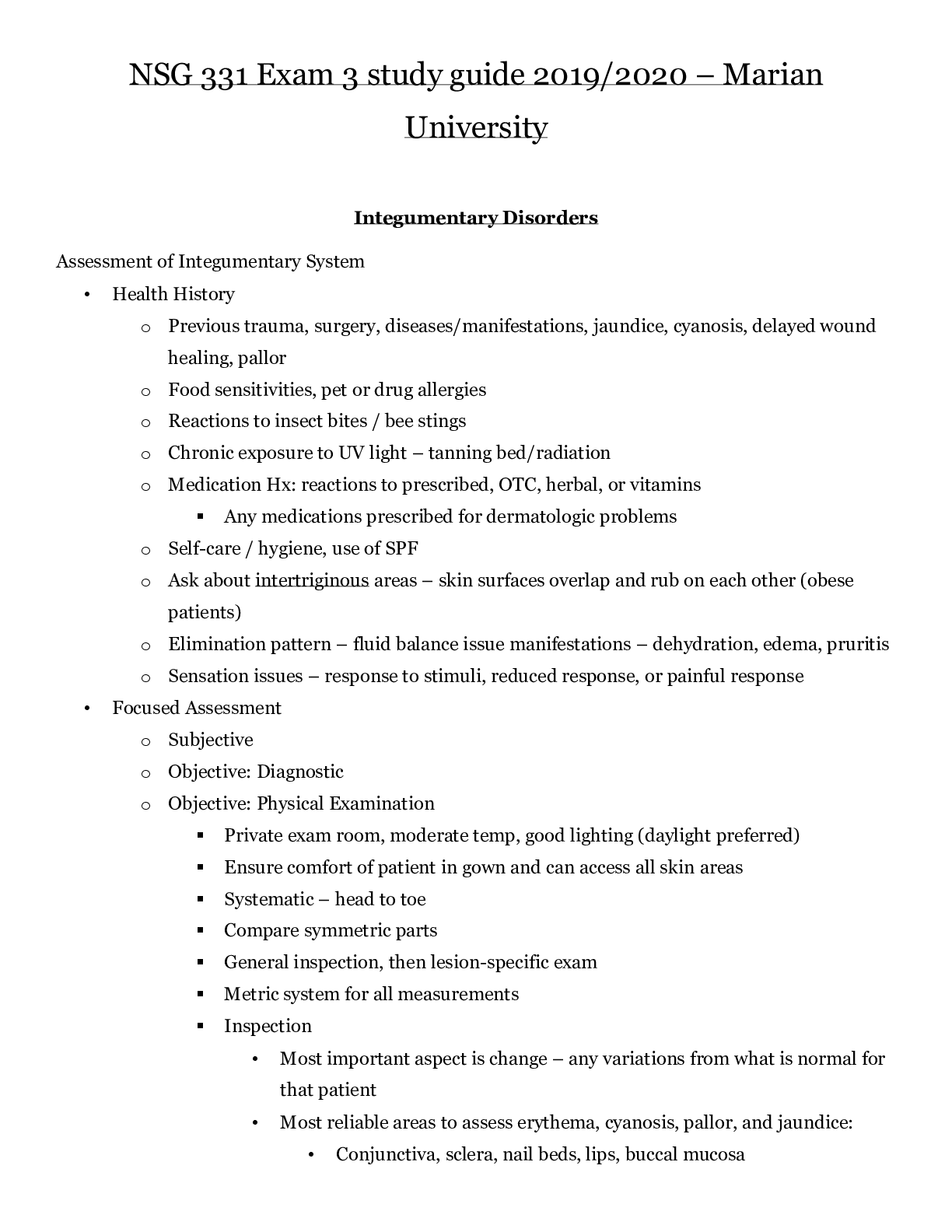
Buy this document to get the full access instantly
Instant Download Access after purchase
Add to cartInstant download
Reviews( 0 )
Document information
Connected school, study & course
About the document
Uploaded On
Jul 04, 2020
Number of pages
119
Written in
Additional information
This document has been written for:
Uploaded
Jul 04, 2020
Downloads
0
Views
46

